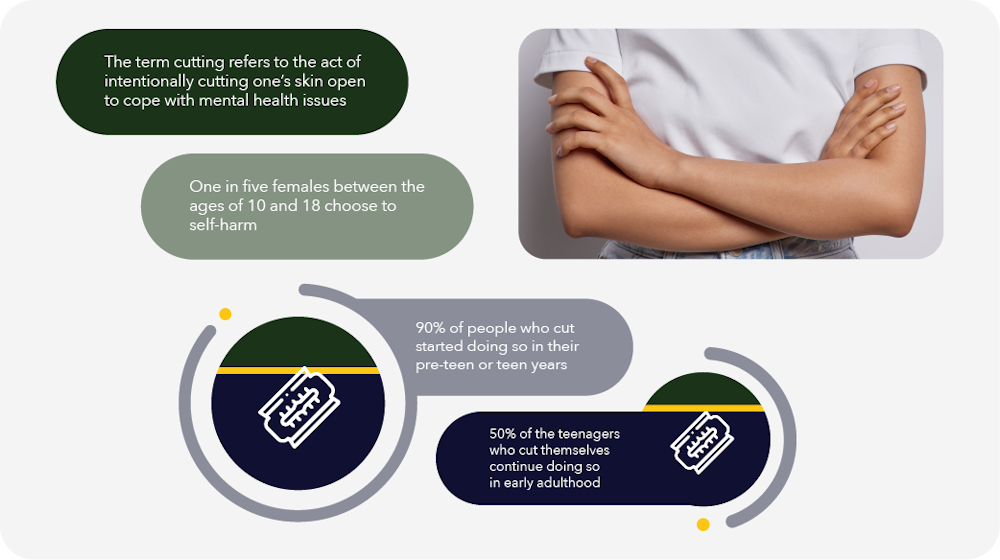Treatment for Self-Harm
As teenagers transition from childhood to young adulthood, they often deal with a large amount of stress and growing pains. Unfortunately, many teens develop unhealthy ways to cope with this stress. For example, cutting oneself has become a concerning way that many teens cope with their stress and anxiety. Cutting can also be a sign of a larger, more alarming issue that requires rehab for self-harm. At Ridge RTC, we offer treatment for suicidal ideation in teens for instances where the teen or young adult’s life may be in danger.
Cutting in teens has unfortunately become more prevalent in society today. Because of the dangers of teenage cutting, parents and adults should be knowledgeable about what cutting is and how to treat it.

What is Teenage Cutting?
The term cutting refers to the act of intentionally cutting one’s skin open to cope. The term teenage cutting refers to the trend of teenagers choosing to cut themselves to cope with stress and anxiety.
WHY IS TEENAGE SELF-HARM PREVALENT?
There are many reasons why teenagers, in particular, have a reputation for cutting themselves to cope with the stresses of life. The teenage years are often a stressful time in a person’s life due to growing up, being given more responsibilities, and being held more accountable for one’s actions. It also doesn’t help that teenagers are highly hormonal.
There are many other reasons why teenagers often cut themselves to cope outside of just being stressed and dealing with growing pains and hormones. For example, cutting often causes people to feel a release of emotions. Therefore, when teenagers are dealing with intense, negative emotions that they can’t seem to get rid of, cutting themselves can help them release their negative emotions.
Cutting can even give some people a high-like feeling that becomes addictive. Thus, it makes sense that many teenagers can’t stop cutting themselves.
Some teenagers also cut themselves as a form of self-punishment. The act of punishing oneself is often mentally unhealthy. Therefore, teenagers who choose such a drastic and harmful behavior to punish themselves should seek out therapy immediately.
Depressed teenagers may even choose to cut themselves just to feel anything at all. Any teenager who expresses that he or she is cutting himself just to feel should also seek out rehab for depressed teens immediately.
Teenage Cutting vs. Attempting to Commit Suicide
While cutting open one’s skin with a sharp device such as a knife may seem like a way that someone is trying to kill themself, this is usually not true. In fact, most teenagers who cut themselves never attempt to commit suicide. This is because to them, cutting is a form of emotional release rather than a method to end their lives.
Statistics on Cutting in Teens
Because teenagers often use cutting as a form of emotional release, it shouldn’t be surprising that many teens who choose to cut themselves have experienced trauma and/or are suffering from mental health disorders. In fact, studies have shown there is an association between self-harming behaviors and instances of childhood sexual abuse. Other statistical data on cutting in teens include:
- 90% of people who cut themselves started doing so in their pre-teen or teen years.
- Adolescent girls are more likely to start cutting themselves than adolescent boys.
- About half of the teenagers who choose to start cutting themselves continue to do so in early adulthood.
- One in five, or 20%, of females between the ages of 10 and 18 choose to self-harm themselves. Ways that these young females often choose to self-harm include cutting or burning.
Types of Cutting
There are many different ways that teenagers can cut themselves. One is by cutting or piercing the skin with a sharp object like a knife. Another way to cut oneself is by inserting sharp objects into the body or under the skin.
Carving or branding something or someone into the skin is also a form of cutting. Intensively scratching oneself with fingernails or one’s teeth can even be seen as a form of cutting.
Mental Health Issues Often Associated with Teenage Cutting
Substance use disorders often correlate with cutting in teens. Oftentimes, teenagers who cut themselves also suffer from mental health disorders. Some mental health disorders that are often associated with cutting in teens include the following:
- Borderline personality disorder
- Eating disorders such as anorexia and bulimia
- Post-traumatic stress disorder (PTSD)
- Bipolar disorder (Teen Bipolar Treatment)
- Depression
- Obsessive-compulsive disorder (OCD)
- Anxiety disorders
- Schizophrenia
- Conduct disorder
- Oppositional defiant disorder
Signs and Symptoms of Cutting in Teens
There are numerous signs and symptoms of cutting in teens. Some of the more common ones that parents and caretakers should be aware of include the following:
- Finding sharp objects hidden in a teen’s bedroom, clothing, or bags
- Random cuts, carvings, and/or scratches on the body, especially on one’s arms, legs, thighs, and torso.
- Doctors, nurses, teachers, and/or coaches mention noticing suspicious wounds or scars on the teen’s body.
- Someone, often a family member or friend, claims to have witnessed the teen cut him or herself.
- The teen is suddenly always insisting on wearing long sleeves or pants even when it’s hot outside.
- The teen is spending a suspicious amount of time in his or her bedroom with the door closed and/or locked. This especially might occur after a fight with a family member or friend.
- Seeing blood, whether fresh or dried up, on sharp objects in a teen’s car, bedroom, or bathroom.
How to Help Prevent Cutting in Teens
To prevent a teenager from starting to cut him or herself, parents and caretakers should make a conscious effort to do the following:
Oftentimes, people don’t listen to what teenagers have to say. As a result, many teens bottle up their stress, anxiety, and emotions. This can later cause them to develop unhealthy ways of coping, such as cutting.
To help teenagers release their pent-up stress, anxiety, and emotions in a healthy manner, talk to them in an empathetic manner. Listen to their feelings of shame, fears, and concerns. Doing so can not only help prevent teens from developing unhealthy coping mechanisms, but it can also help parents and caretakers develop better relationships with their teens. Talking with teens can even help parents and caretakers get a better insight into who their teens really are.
When parents and caretakers support and encourage their teenagers, it can go a long way. One way to do this is by supporting the teenagers’ passions. Another way to support and encourage teens is by giving them positive words of encouragement and affirmation.
Parents and caretakers can even show support and encouragement by simply always being there to help the teen in a compassionate manner when he or she is down or needs it. Showing one’s reliability as a parent or caretaker through actions is often stronger than any words that one can say.
Sometimes, teenage cutting occurs despite all the support and encouragement that a parent or caretaker provides. The best thing that a parent or caretaker can do when this happens is to get the teen the professional help that he or she needs. In a case of an emergency, that means calling 911 and sending the teen to the emergency room. In most cases though, getting a teen who is cutting him or herself help means having an intervention and sending the teen to therapy or treatment.
Forms of Therapy That Can Help Prevent Cutting in Teens
Therapy for teenage cutting isn’t always just for teenagers who already have cutting problems. Sometimes, it’s also for teens with mental health struggles who are considering cutting themselves or are exhibiting signs of heading down a dark path that will likely lead to cutting.
There are many different forms of therapy that can help prevent or treat cutting in teens. Some of the main ones include:
- Cognitive-behavioral therapy (CBT)
- Dialectical behavior therapy (DBT)
- Psychodynamic psychotherapy
- Mindfulness-based therapy
- Family therapy

SELF-HARM TREATMENT FOR TEENS
Sometimes, therapy alone isn’t enough to treat cutting in teens. If a teenager is suffering from intense mental health issues along with cutting and/or suicidal thoughts, he or she likely needs to receive treatment that’s intensive.
The intensive levels of cutting treatment that a teen who needs more care than traditional outpatient forms of therapy provides include the following:
Inpatient psychiatric treatment is the most intensive form of treatment. Parents and caretakers who plan to send their teenagers to this form of treatment for cutting choose to admit the teenagers to an adolescent psychiatric hospital unit. The medical personnel will monitor the teenagers 24/7. Inpatient psychiatric treatment for teenage cutting is for teens who are actively suicidal and present a danger to themselves.
Just like with substance abuse treatment, teenagers who receive residential treatment for cutting live in a treatment facility 24/7 while receiving care. Residential teen self-harm treatment centers that treat self-harm also usually specialize in mental health treatment for teens. Thus, a teen receiving residential cutting treatment can simultaneously treat his or her cutting issues and mental health issues. Residential treatment for cutting in teens should last around 30 to 180 days.
Intensive outpatient treatment (IOP), or psychiatric day treatment for cutting, is a step up in level of care from typical outpatient therapy. Teens with cutting problems that have just reached a level of severity that cannot be managed through typical weekly outpatient psychotherapy often require Intensive Outpatient Therapy (IOP).
Intensive outpatient treatment for teenage cutting allows teenagers to spend the night in their own homes. Still, it requires that teens receive intensive psychiatric care for extended periods of time, multiple times a week. The number of treatment sessions a patient must attend will vary depending on the individual’s needs.
Regardless of what form of intensive cutting treatment a teenager receives, it will require the teen to receive daily or bi-weekly visits with a psychiatrist and various types of daily therapy.

Help Prevent Cutting in Teens at Ridge RTC
Ridge RTC is a 350-acre residential treatment facility that caters to the therapeutic needs of adolescents. We provide compassionate care for teenagers in need of IOP or self-harm residential treatment.
Ridge RTC offers its patients and residents specialized therapies alongside treatment activities that are tailored to each of the patient’s unique needs. These specialized therapies and treatment activities include the ones that typically treat cutting.
To learn more about Ridge RTC and how we can help your teen achieve recovery from cutting, contact us today over the phone or by web message. We will answer any questions that you may have.
